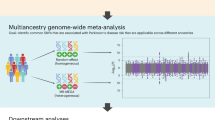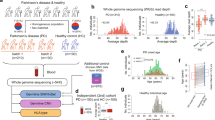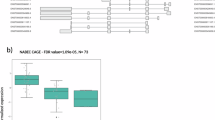Abstract
Parkinson's disease (PD) is a complex neurodegenerative disease which is clinically heterogeneous and pathologically consists of loss of dopaminergic neurons in the substantia nigra and intracytoplasmic neuronal inclusions containing alpha-synuclein aggregations known as Lewy bodies. Although the majority of PD is idiopathic, pathogenic mutations in several mendelian genes have been successfully identified through linkage analyses. To identify susceptibility loci for idiopathic PD, several genome-wide association studies (GWAS) within different populations have recently been conducted in both idiopathic and familial forms of PD. These analyses have confirmed SNCA and MAPT as loci harboring PD susceptibility. In addition, the GWAS identified several other genetic loci suggestively associated with the risk of PD; among these, only one was replicated by two different studies of European and Asian ancestries. Hence, we investigated this novel locus known as PARK16 for coding mutations in a large series of idiopathic pathologically proven PD cases, and also conducted an association study in a case–control cohort from the United Kingdom. An association between a novel RAB7L1 mutation, c.379-12insT, and disease (P-value=0.0325) was identified. Two novel coding variants present only in the PD cohort were also identified within the RAB7L1 (p.K157R) and SLC41A1 (p.A350V) genes. No copy number variation analyses have yet been performed within this recently identified locus. We concluded that, although both coding variants and risk alleles within the PARK16 locus seem to be rare, further molecular analyses within the PARK16 locus and within different populations are required in order to examine its biochemical role in the disease process.
Similar content being viewed by others
Log in or create a free account to read this content
Gain free access to this article, as well as selected content from this journal and more on nature.com
or
References
Lees AJ, Hardy J, Revesz T : Parkinson's disease. Lancet 2009; 373: 2055–2066.
Hardy J, Lewis P, Revesz T, Lees A, Paisan-Ruiz C : The genetics of Parkinson's syndromes: a critical review. Curr Opin Genet Dev 2009; 19: 254–265.
Winkler S, Hagenah J, Lincoln S et al: alpha-Synuclein and Parkinson disease susceptibility. Neurology 2007; 69: 1745–1750.
Skipper L, Li Y, Bonnard C et al: Comprehensive evaluation of common genetic variation within LRRK2 reveals evidence for association with sporadic Parkinson's disease. Hum Mol Genet 2005; 14: 3549–3556.
Di Fonzo A, Wu-Chou YH, Lu CS et al: A common missense variant in the LRRK2 gene, Gly2385Arg, associated with Parkinson's disease risk in Taiwan. Neurogenetics 2006; 7: 133–138.
Ross OA, Wu YR, Lee MC et al: Analysis of Lrrk2 R1628P as a risk factor for Parkinson's disease. Ann Neurol 2008; 64: 88–92.
Paisan-Ruiz C, Washecka N, Nath P, Singleton AB, Corder EH : Parkinson's disease and low frequency alleles found together throughout LRRK2. Ann Hum Genet 2009; 73: 391–403.
Sidransky E, Nalls MA, Aasly JO et al: Multicenter analysis of glucocerebrosidase mutations in Parkinson's disease. N Engl J Med 2009; 361: 1651–1661.
Paisan-Ruiz C : LRRK2 gene variation and its contribution to Parkinson disease. Hum Mutat 2009; 30: 1153–1160.
Hardy J, Singleton A : Genomewide association studies and human disease. N Engl J Med 2009; 360: 1759–1768.
Pankratz N, Wilk JB, Latourelle JC et al: Genomewide association study for susceptibility genes contributing to familial Parkinson disease. Hum Genet 2009; 124: 593–605.
Satake W, Nakabayashi Y, Mizuta I et al: Genome-wide association study identifies common variants at four loci as genetic risk factors for Parkinson's disease. Nat Genet 2009; 41: 1303–1307.
Simon-Sanchez J, Schulte C, Bras JM et al: Genome-wide association study reveals genetic risk underlying Parkinson's disease. Nat Genet 2009; 41: 1308–1312.
Edwards TL, Scott WK, Almonte C et al: Genome-wide association study confirms SNPs in SNCA and the MAPT region as common risk factors for Parkinson disease. Ann Hum Genet 2010; 74: 97–109.
Gibb WR, Lees AJ : The relevance of the Lewy body to the pathogenesis of idiopathic Parkinson's disease. J Neurol Neurosurg Psychiatry 1988; 51: 745–752.
Hughes AJ, Daniel SE, Kilford L, Lees AJ : Accuracy of clinical diagnosis of idiopathic Parkinson's disease: a clinico-pathological study of 100 cases. J Neurol Neurosurg Psychiatry 1992; 55: 181–184.
Edgar RC : MUSCLE: multiple sequence alignment with high accuracy and high throughput. Nucleic Acids Res 2004; 32: 1792–1797.
Greggio E, Cookson MR : Leucine-rich repeat kinase 2 mutations and Parkinson's disease: three questions. ASN Neuro 2009; 1: e00002.
Cooper AA, Gitler AD, Cashikar A et al: Alpha-synuclein blocks ER-Golgi traffic and Rab1 rescues neuron loss in Parkinson's models. Science 2006; 313: 324–328.
Gitler AD, Bevis BJ, Shorter J et al: The Parkinson's disease protein alpha-synuclein disrupts cellular Rab homeostasis. Proc Natl Acad Sci USA 2008; 105: 145–150.
Bolognin S, Messori L, Zatta P : Metal ion physiopathology in neurodegenerative disorders. Neuromolecular Med 2009; 11: 223–238.
Kolisek M, Launay P, Beck A et al: SLC41A1 is a novel mammalian Mg2+ carrier. J Biol Chem 2008; 283: 16235–16247.
Evans W, Fung HC, Steele J et al: The tau H2 haplotype is almost exclusively Caucasian in origin. Neurosci Lett 2004; 369: 183–185.
Acknowledgements
We thank all patients who participated in this study and all families who supported the donation of tissue for research. We also thank The Medical Research Council (MRC; HH: MRC fellowships G108/638 and G0802760 and JH: start-up funds) and The Michael J Fox Foundation (HH and CPR) for support. This study was also supported by the NIHR UCLH/UCL Comprehensive Biomedical Research Centre. MAN and ABS were partly supported in this research by the Intramural Research Program of the NIH, National Institute on Aging (AG000957-07 (2009) Assessment of Candidate Loci in Neurological diseases).
Author information
Authors and Affiliations
Corresponding author
Ethics declarations
Competing interests
The authors declare no conflict of interest.
Additional information
Supplementary Information accompanies the paper on European Journal of Human Genetics website
Supplementary information
Rights and permissions
About this article
Cite this article
Tucci, A., Nalls, M., Houlden, H. et al. Genetic variability at the PARK16 locus. Eur J Hum Genet 18, 1356–1359 (2010). https://doi.org/10.1038/ejhg.2010.125
Received:
Revised:
Accepted:
Published:
Issue date:
DOI: https://doi.org/10.1038/ejhg.2010.125
Keywords
This article is cited by
-
Ethnicity- and sex-specific genome wide association study on Parkinson’s disease
npj Parkinson's Disease (2023)
-
Study of cognitive impairment and genetic polymorphism of SLC41A1 (rs11240569 allele) in Parkinson’s disease in Upper Egypt: case-control study
The Egyptian Journal of Neurology, Psychiatry and Neurosurgery (2021)
-
Autophagic and endo-lysosomal dysfunction in neurodegenerative disease
Molecular Brain (2019)
-
Recent Developments in LRRK2-Targeted Therapy for Parkinson’s Disease
Drugs (2019)
-
Fine mapping and resequencing of the PARK16 locus in Parkinson’s disease
Journal of Human Genetics (2015)



